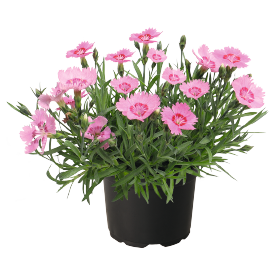

RoseQuartz
- FastraX perennial: First year flowering without vernalization
- Dainty flowers with dark rose ring
- Sweet scent
- Long flowering period throughout the summer
- Crop Time
- Spring: 11 - 13 weeks
- Height ∅
- 12 ″ / 30 cm
- Exposure
- Sun - Partial shade
- Seed Form
- BeGreen Pelleting
- Heat Zone
- 9-1
- Hardiness Zone
- 4a-9b
- Product Use
- Landscape
Technical guide
Usage
Perennial, first year flowering. Pot plant for sales from May onwards, for use in containers, borders, and rock gardens.
Sow time
February-April for flowering in May-July; August-September for flowering in the following year
Sowing method
Multiple sow, 3-5 seeds per plug. Alternatively, direct sow in the final pot.
Germination
10-20 days at 70-75 °F (21-24 °C).
Growing on
Transplant plugs in late winter through early spring.
Media
Use a friable, coarse-fibered substrate with a pH of 5.5-5.8.
Temperature
15-18 °C / 59-64 °F, start ventilating at 20 °C / 68 °F. A minimum temperature of 15 °C is required for flowering to occur. Plants may be overwintered at 3-5 °C / 37-41 °F.
Fertilization
Requires low nutrient levels.
Stage I Starts with the radicle breaking through the testa. The roots are touching the medium. Ends with fully developed cotyledons.
Stage II Starts from fully developed cotyledons. Ends with the fully developed true leaf or true leaf pair.
Stage III Starts from the fully developed true leaf or true leaf pair and ends with 80% of the young plants being marketable.
Stage IV All young plants are ready for sale and in the process of being hardened off. This stage lasts about 7 days.
The cultural recommendations are based on results from trials conducted under Central European conditions. Different conditions in other parts of the world may lead to deviations in results achieved.

